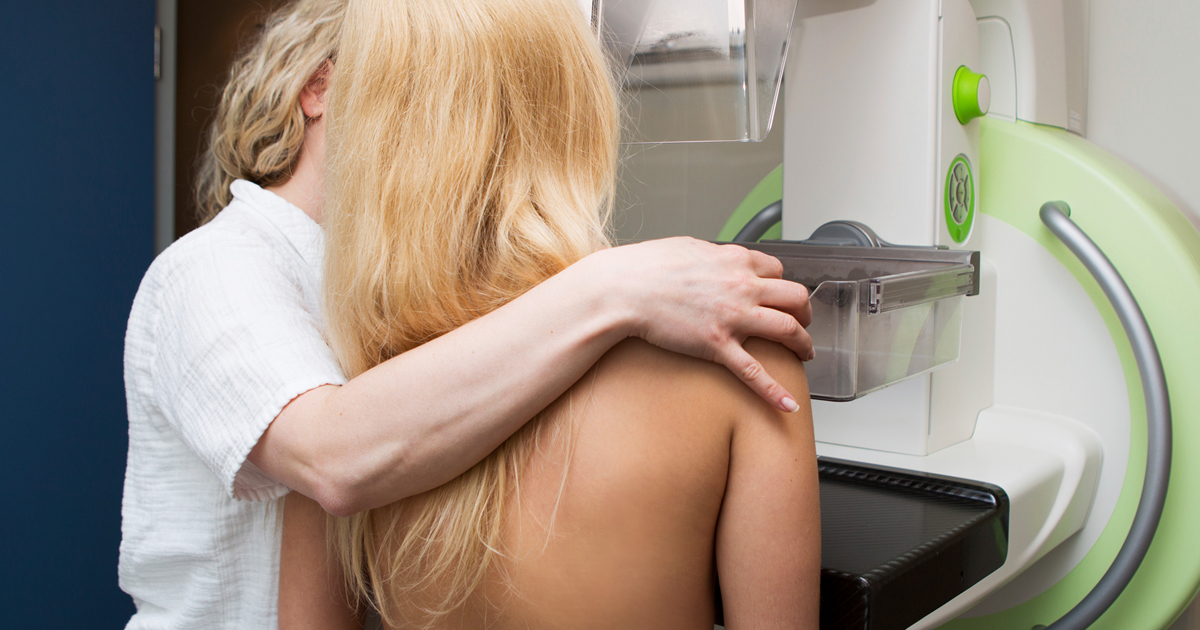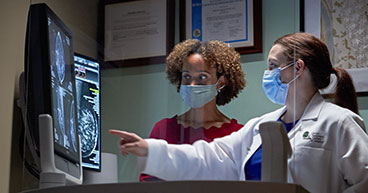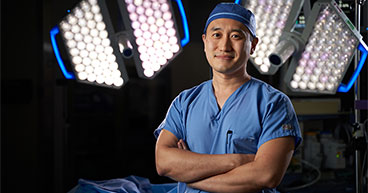
Of the many risk factors for breast cancer, one that develops naturally and is very common is dense breasts. Up to 50 percent of all women aged 40 and older have dense breasts.
“In most cases, there’s nothing you can do about it,” Anita Johnson, MD, FACS, Chief of Surgery at Cancer Treatment Centers of America® (CTCA), Atlanta, and Leader of the Atlanta Women’s Cancer Center, said in a recent TV feature. “It’s just the way that you were born, and it’s just part of your body.”
Having dense breasts simply means you have a lot of fibrous tissue in the breasts instead of fatty tissue. However, having dense breast tissue raises your risk of developing breast cancer, and it may hide tumors and other abnormalities.
While you can’t change your breast density, you may manage your risk by taking proactive measures like getting regular mammograms and other screening tests and following healthy lifestyle behaviors.
In this article, we’ll answer these common questions:
- What causes dense breast tissue?
- Are dense breasts firmer?
- Dense breast tissue and cancer: What’s the link?
- What should you do if you have dense breasts?
- Tips for lowering breast cancer risk
If you’ve been diagnosed with breast cancer and would like to learn more about our treatment options at CTCA®, or if you’re interested in a second opinion about your cancer diagnosis and treatment plan, call us or chat online with a member of our team.
What causes dense breast tissue?
The breast is made up of three types of tissues:
- Fibrous tissue, which holds the breast tissue in place
- Glandular tissue, which makes milk
- Fatty tissue, which fills the space between the fibrous tissue, the lobes (the glandular tissue) and the ducts (the tubes that carry milk to the nipple), giving the breasts their size and shape
Together, fibrous and glandular tissue are called fibroglandular tissue. Breast density refers to the amount of fibroglandular tissue compared to the amount of fatty tissue in the breasts.
Women who have a family history of dense breast tissue are more likely to have dense breasts. However, the density of breast tissue may change over time.
You’re also more likely to have dense breasts if you:
- Are younger
- Have a lower body mass index
- Are using hormone therapy to relieve menopause symptoms
- Are pregnant or breastfeeding
You likely won’t know whether you have dense breasts until you start getting mammograms.
Thirty-six states now require providers to let you know if your mammogram shows you have dense breasts. If your provider sends you a letter letting you know you have dense breasts, the letter should include the category of your breast density. This category will also show on your mammography report.
Doctors use the Breast Imaging Reporting and Data System (BI-RADS), developed by the American College of Radiology, to classify breast density. It helps them interpret and report back on mammogram findings.
The four categories for breast density are explained below.
Heterogeneously dense breast tissue
Heterogeneously dense breast tissue refers to breasts that have many areas of glandular tissue and fibrous connective tissue.
About 40 percent of women have heterogeneously dense breast tissue.
Extremely dense breasts
Extremely dense breast tissue is mostly fibrous and contains very little fat. This type of breast tissue shows up as gray or white on a mammogram, making it harder to see abnormalities such as tumors or calcifications, which are also gray or white.
“On a mammogram, it looks like a cloud,” Dr. Johnson said in the Fox5 Atlanta feature. “Most breast tissue is a combination of fatty and fibrous tissue. So, very dense breast tissue just means you have lots of fibrous tissue.”
About 10 percent of women have extremely dense breast tissue.
Scattered fibroglandular breast tissue
Scattered fibroglandular breast tissue is made up of both dense glandular tissue and fibrous tissue. About 40 percent of women have this type of tissue.
Almost entirely fatty breast tissue
Fatty breast tissue looks almost black on a mammogram, making it easier to see gray or white tumors or calcifications.
About 10 percent of women have almost entirely fatty breast tissue.
Are dense breasts firmer?
It may seem logical to think that the firmness of your breasts could indicate whether they’re dense. But that’s not the case. The only way to tell your breast density is through mammography.
A radiologist will read your mammogram report to determine the density of your breasts and whether to recommend further breast imaging.
Dense breast tissue and cancer: What’s the link?
While dense breasts are very common, women with dense breasts have a higher risk of breast cancer than women with fatty breasts, according to the National Cancer Institute. Several ongoing research studies are exploring the link between dense breast tissue and cancer, but so far, the connection isn’t clear.
Still, research has found that breast cancer patients who have dense breasts are no more likely to die from the disease than breast cancer patients who have fatty breasts.
What should you do if you have dense breasts?
Remember when Katie Couric, journalist and former Today show host, went public about her breast cancer diagnosis last September? She received a 3D mammogram, also called digital breast tomosynthesis (DBT), which is considered a major advancement in breast cancer detection. DBT doesn’t exactly produce a 3D image of the breast. 3D mammography captures multiple images from various angles to provide a more complete picture.
At the time of her announcement, Couric revealed she has dense breasts, so she often gets additional screenings. After her 3D mammogram, she underwent a breast ultrasound, which revealed an anomaly. Her doctors initially speculated it was a scar from a past breast reduction surgery, but a biopsy revealed it was cancer.
According to the United States Preventive Services Task Force, it’s not yet clear whether additional imaging tests like ultrasound or breast MRI are needed to screen for breast cancer in women with dense breasts.
That’s why it’s important to talk to your doctor. Discuss your breast cancer risk factors with your doctor and whether additional screenings and vigilance are needed for you based on your personal medical and family history, Dr. Johnson says.
Also, if you get a call after your mammogram saying more imaging tests are needed, don’t panic, Dr. Johnson says. Most callbacks don’t turn out to be cancer. “Less than 50 percent of the time is it something you need to be concerned about, either as a pre-cancerous lesion or cancer,” she says.
Tips for lowering breast cancer risk
In addition to managing your risk through breast cancer screenings, you may lower your risk by following these tips for maintaining a healthy lifestyle:
- Eating a diet low in animal fats
- Limiting alcohol consumption
- Getting regular exercise
- Maintaining a healthy weight
- Avoiding cigarettes and tobacco
- Getting adequate amounts of vitamin D and calcium
“I tell all my patients the same thing,” says Dennis Citrin, MB ChB, PhD, Medical Oncologist who treats breast cancer patients at CTCA Chicago. “Make sure you get your annual screening mammograms, and check your breasts on a regular basis. Be familiar with your breasts, particularly if you’re pre-menopausal. If anything feels different, see your doctor right away.”
If you’ve been diagnosed with breast cancer and would like to learn more about our treatment options at CTCA, or if you’re interested in a second opinion about your cancer diagnosis and treatment plan, call us or chat online with a member of our team.



